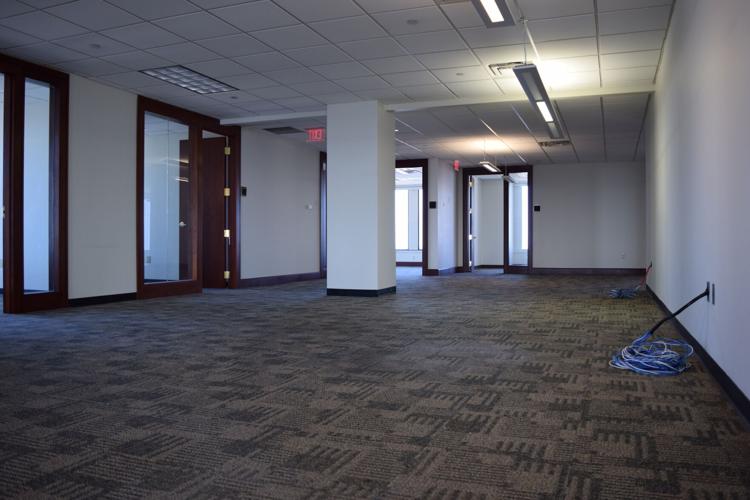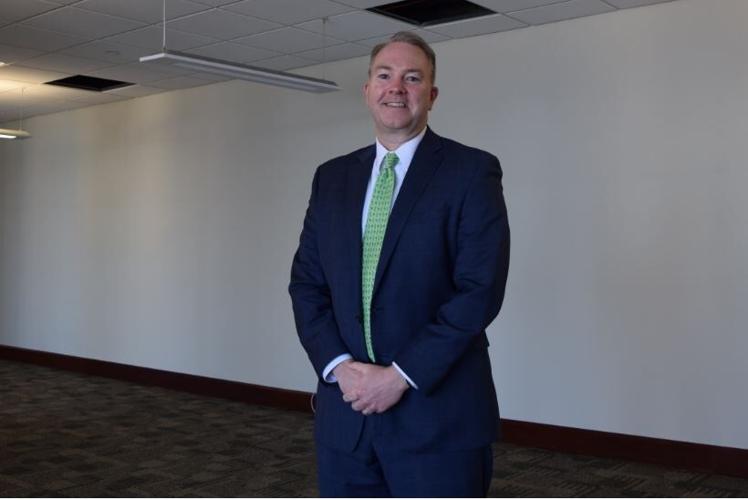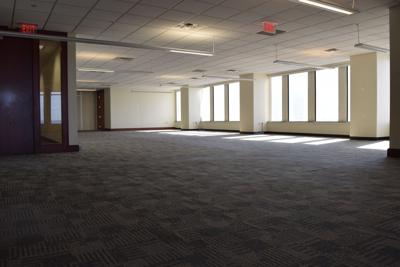LOUISVILLE, Ky. (WDRB) – On the 23rd floor of 500 W. Jefferson Street, one of Louisville’s biggest office buildings, sunlight beams from windows overlooking the Ohio River, revealing an expanse of aging carpet. Bundles of ethernet cables protrude from the walls. With no workstations needing connections, the cables drape to the floor.
This prime downtown workspace was empty long before the COVID-19 pandemic sent Louisville’s office workers on a forced march toward work-from-home arrangements last year.
It used to belong PNC Bank, which for decades was the anchor tenant of the building, which was then called PNC Plaza.
But in 2017, the bank vacated the 23rd floor and about five other floors in 500 W. Jefferson, consolidating its Louisville workforce into the city’s biggest office building, PNC Tower at 5th and Main streets.
The pandemic was a punch in the gut to the market for office space in Louisville’s Central Business District. But in many ways, the market was already on the ropes.
Over the last decade or so, downtown Louisville has seen the construction of the KFC Yum! Center, the 30-story Omni Hotel, a dozen other new or renovated hotels, a renovated convention center and bourbon attractions like the Old Forester Distillery.
Yet, even as bourbon tourists poured in and new restaurants and bars popped up, the amount of occupied office space in the Central Business District didn’t grow in the decade leading up to the pandemic.
Rick Ashton, a longtime Louisville office broker with JLL, at 500 W. Jefferson Street. Feb. 3, 2021
“If you’re flat over a 10-year period, that’s not a healthy market,” said Rick Ashton, a longtime office broker with the Louisville office of JLL.
And now that the pandemic has pushed office workers into at-home arrangements for nearly a year, the fear is that companies will permanently downsize their office footprints.
Whenever COVID-19 subsides, there is no debate about whether work-from-home trends will continue – only the degree to which they will.
“People are habit-forming, and some of these habits are going to stick,” said Franklin Jelsma, managing partner of Wyatt Tarrant & Combs, one of Louisville’s biggest law firms.
Most of the firm’s roughly 65 attorneys have been working from home since pandemic began, and Jelsma said many would likely prefer to continue even if COVID-19 suddenly disappeared.
The vacancy rate for “Class A” office space – the sort of prime space occupied by banks, law firms and corporate headquarters -- in Louisville’s Central Business District surged to nearly 22% at the end of 2020, the highest in JLL’s annual records dating to 2007.
It’s been the mirror trend for Louisville’s suburban office space, where vacancy has steadily decreased over the last decade.
Several factors played into office downtown office vacancies, and the pandemic “exacerbated” those trends, Ashton said.
Work-from-home was already on the rise in Louisville and nationally from 2010 to 2019, according to Census data. About 5% of the workforce was home-based in 2019, up from about 3% a decade earlier.
Louisville has been the victim of corporate consolidation, like when PNC shrunk its footprint five years ago.
Downtown hasn’t seen a newly constructed office tower since 400 W. Market Street was built in the early 1990s. If companies want the most eye-popping space for their employees, the place to get it is in eastern Jefferson County the suburbs.
Rental rates, according to Ashton, justify the economics of building office space in the suburbs – like the new building in the ShelbyHurst campus at Shelbyville Road and Hurstbourne Parkway that lured accounting firm Dean Dorton and its 100 employees away from their space at 500 W. Jefferson last year.
Technology has replaced support workers at law firms, banks and accountant’s offices, and reduced their need to store paper files.
In 2019, Wyatt Tarrant & Combs shed nearly half of its space by leaving 500 W. Jefferson St. and taking up residence in 400 W. Market St.
The old space, Jelsma said, was a relic from the days when law firms needed a receptionist on every floor, multiple law libraries with physical books and lots of conference rooms for client meetings and deal closings that no longer happen face-to-face.
“You finally realize, ‘why am I wearing a tie when I am not going to see a client today?’” he said.
Like other central cities, downtown Louisville’s office market took a step backward in 2020. More space was vacated by office tenants like Dean Dorton than absorbed in new leases.
At the end of 2020, there was more than 1 million square feet of vacant office space among downtown Louisville’s 19 biggest buildings alone, according to JLL. The unleased space is the equivalent of the entire 39-story PNC Tower plus the 26-story Meidinger Tower.
This image by real estate brokerage JLL depicts available floors in Louisville's biggest downtown office buildings as of the end of 2020.
Those vacancy figures are derived from space advertised for lease. Another concern, Ashton said, is a significant amount of "shadow space" that isn't quantified -- space that is leased, but isn't being used and could be shed once companies have the opportunity.
Civic boosters point out that Louisville isn’t the only mid-market city struggling with emptiness in its urban core during the pandemic.
Louisville’s vacancy rate for prime downtown space is higher than regional cities, according to figures from JLL, but not wildly out of line.
Humana primarily work-from-home
Ashton said none of those other cities is “as reliant on one tenant/user” for downtown office space as Louisville is with Humana Inc., its biggest corporate headquarters. Humana is both the biggest occupant of buildings it owns, like its main office at 500 W. Main Street, and the biggest tenant of leased space in downtown.
Humana said in a regulatory filing last week that 94% of its roughly 48,000 employees are working from home in the pandemic, which also applies to its roughly 12,000 Louisville-based workers, according to spokeswoman Jahna Lindsay Jones.
Humana was already moving toward home-based work before COVID-19. Prior to the pandemic, about 35% of its workers were based at home, Jones said. In 2019, Humana vacated several floors in PNC Tower, a move that resulted from the company’s periodic evaluation of its needs, Jones said.
“We realized that we no longer needed the space in the PNC Tower and consolidated our operations into other owned and leased space,” she said.
With the pandemic still ongoing, Jones said Humana is in no rush to return workers to the office.
“We do not have a specific timeline, as there are many unknowns about the virus and vaccine supply at this time. Our associates’ health and safety are our top priorities,” she said in an email.
When COVID-19 subsides, Jones said it’s too soon to say what share of Humana workforce might return to the office or whether the company will need the same amount of space.
“There are no immediate plans to downsize,” she said. “At the same time, we are always looking at our real estate portfolio to ensure it meets the needs of our associates and our customers and we will continue to do that now and into the future.”
Last year Humana decided to put some of its empty space to good use by partnering with Jefferson County Public Schools to open a “student and family support center” for virtual school on the first two floors of the company’s Clocktower Building on East Main Street.
Retail, restaurant struggle
The absence of office workers, tourists and convention-goers has closed dozens of stores, attractions and restaurants downtown – to name a few, Eddie Merlot’s steakhouse, the Hard Rock Café, Jim Beam’s Urban Stillhouse, El Taco Luchador at 500 W. Jefferson Street and Dish on Market.
Street-level businesses also suffered among boarded up windows last summer during months of racial justice protests in the wake of the police killing of Louisville resident Breonna Taylor.
Another Place Sandwich Shop, a 50-year-old lunch joint on Seventh Street, finally called it quits earlier this month.
As fewer customers came through the door in 2020, the sandwich shop’s transactions dropped by 70% to 80%, said Allison Price, one of the business’ owners.
“I have never seen it the way that it’s been this year; it’s certainly a ghost town. There’s just nothing down there. Nobody’s down there anymore,” she said.
Price acknowledged the impact of “basically everybody” moving to work-from-home, but she also blames news media for overhyping last summer’s protests, “making the world think that Louisville was, like, destroying its city for six months.”
In fact, Price said, she thinks downtown is “the safest it’s ever been” and was flourishing with redevelopment and increased tourism before the pandemic.
Price said her shop received a COVID-19 business loan from Louisville Metro and Paycheck Protection Act funds from the federal government.
But these short-term band aids could not fix her long-term problem: it’s hard to see when customers will return.
“I don’t see why corporations would go back to doing business the way that they were. I don’t see why there would be that many people in offices ever again,” she said. “…I just think that people will be working from home a lot more from here on out.”

PNC Bank used to occupy the 23rd floor of 500 W. Jefferson Street (formerly PNC Plaza), but the bank vacated the building in 2016, consolidating into PNC Tower at 5th and Main streets.
At-home work just as productive
Research may prove Price correct.
Last year, economists at the Becker Friedman Institute for Economics at the University of Chicago surveyed 15,000 working-age people and concluded that “working from home will likely stick.”
Among the reasons, the researchers said, is that employees report increased productivity at home.
“The pandemic forced workers and firms to experiment with working from home en masse, enabling them to learn how well it actually works,” the authors wrote.
Jim Allen, vice chairman of financial services firm Baird and the leader of its Louisville office, said he was surprised how effectively his 170-employee team transitioned to remote work last year.
“It’s happened remarkably well. Productivity has been maintained,” he said.
At Baird’s office on the 10th floor of 500 W. Jefferson, the empty receptionist’s desk still had a desktop calendar turned to April 2020.
Baird is an example of the pre-pandemic trends working against Louisville’s downtown office scene, and also an example of what makes some hopeful for its future.
The business used to be called Hilliard Lyons. In 2019, Kentucky-based conglomerate Houchens Industries sold Hilliard Lyons to Milwaukee-based Baird.
Consolidation would soon follow as redundant employees were no longer needed. Baird’s downtown Louisville office now has about 170 employees, Allen said. It had about 290 before the sale.
Baird is reducing its footprint in 500 W. Jefferson, but it’s also “recommitting” to the building and to downtown. Later this year, company will leave seven lower floors but take up residence in five floors at the top of the building.
Allen said despite the success of remote work, Baird’s employees will eventually come back to work in person, as will other downtown workers.
“It’s going to be important for us to get people coming back downtown -- workers coming back downtown -- and that will happen over time. And it may take a little longer than we would have hoped because of COVID(-19), the lingering effects,” said Allen, a former chairman of Greater Louisville Inc., the metro chamber of commerce.
Despite the office vacancies, downtown Louisville was on a “wonderful trajectory” before the pandemic, he said.
“There’s been such a significant investment in downtown Louisville -- there is a strong, collective commitment to seeing that through,” he said.
Scott Shoenberger, the CEO of Louisville’s largest downtown office landlord, the Al J. Schneider Co., said he sees interest in the company’s vacant spaces picking up lately.
Shoenberger said the idea that office workers will permanently shift to home work is overblown. He wonders how new workers become ingratiated in the culture of any business without face-to-face interaction.
“How do you understand what leadership is when you are not able to observe it?” he said.
What can be done?
Mayor Greg Fischer earlier this year assembled a “downtown revitalization” committee of city officials, businesspeople and others. As vaccines roll out, the group is looking at how to make downtown more welcoming with the idea that workers and others start coming back around May 1, said Rebecca Fleischaker, co-chief of Louisville Forward, Metro government’s economic development agency.
“A lot of what we’re trying to do is show that it is a safe and clean space. And that’s the most important thing we can do, right away, to try to change that tide,” Fleischaker said.
Doug Owen, another longtime office broker at JLL, is a member of the revitalization committee.
“The number one, and really the main issue standing between a successful downtown resurgence is the perception downtown is unsafe,” Owen told WDRB. “This is due mainly to the increased number of vagrants and panhandlers - of which some are often aggressive - in our downtown. Whether one wants to acknowledge it or not, a continuing presence of vagrants and panhandlers creates a negative perception of an area and negatively impacts its growth. At this moment, downtown simply cannot afford any negative perceptions.”
Natalie Harris, executive director of Louisville’s Coalition for the Homeless, said the pandemic hasn’t increased homelessness in Louisville, but it has made people who are homeless or who have substance abuse problems “more visible.”
Places people used to go during the day – libraries, restaurants, social service appointments, government offices – aren’t always open, she said. Businesspeople complain about homeless people relieving themselves outside, but the eight portable toilets and handwashing stations the city put out in recent months are not enough, she said.
“If we want people to go somewhere, we need to make some welcoming place for people to go,” she said.
Ultimately, Louisville needs to address the root causes of homelessness, such as substance abuse treatment and access to affordable housing, she said.
Ashton, the office broker, said he’d like to see Louisville Metro offer a parking break for companies moving into downtown, as the city owns many of the downtown parking garages.
While new suburban office buildings are often more expensive to lease, the additional cost of downtown parking, whether borne by the company or employees, causes some to balk at downtown locations, he said.
Fleischaker didn’t directly answer whether she would support that idea, but she said that city officials are “trying to get people out of cars” and discourage single-occupancy vehicle usage.
“The resources it takes up and uses on our streets and gas usage and pollution and air quality – all those reasons,” she said.
Ashton also noted that, when companies get city and state economic development subsidies, there is no additional money available to locate downtown compared to any other location in Jefferson County.
Fleischaker said that possibility could be examined, but state government is primarily responsible for how the economic development subsidies work.
Ultimately, some downtown office space may find new life as something else.
That’s what Louisville developer Underhill Associates plans for the vacant Starks building at 4th Street and Muhammad Ali Boulevard.
Jeff Underhill told WDRB last month that his group plans to spend about $100 million buying the building and converting it to 264 residential apartments with creative spaces such as art, dance and recording studios.
“We all feel beat up in the last year in so many ways -- exhausted by what we’re dealing with,” Underhill said. “ …But the exciting things are when you’re beaten down. That’s when the new opportunity presents itself.”





